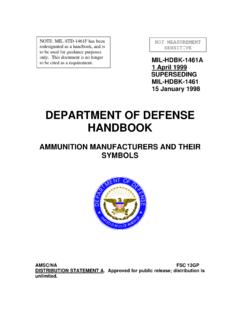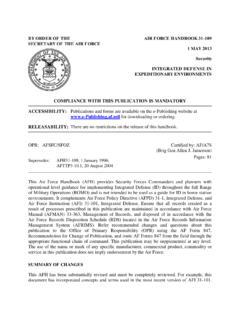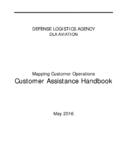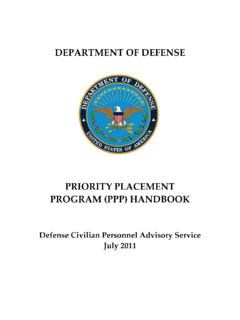Transcription of DTIC N0V 25 199'2 UI - Defense Technical Information Center
1 AD-A258 246-_iIUihIEhEII|10/92 URINALYSISCOORDINATORDTICS ELECTE D* N0V 25 199'2 UIHANDBOOKiTh.! document has been approvedior public release and sale; itstribution is OF NAVAL PERSONNELPERS 63 WASHINGTON DC 20370-5631S92-301882\3 UUU333U1-- 92 11 0 4 DEPARTMENT OF THE NAVYBUREAU OF NAVAL PERSONNELWASHINGTON. 20370-5000 IN REPLY REFER TO5350per 631 MEMORANDUM FOR ALL COMMANDERS, COMMANDING OFFICERS AND OFFICERS-IN-CHARGESubj: URINALYSIS COORDINATOR HANDBOOKRef: (a) OPNAVINST Reference (a) designates the Urinalysis Coordinator as theadvisor to the commanding officer on all matters relating tourinalysis collection and transportation of samples to the NavyDrug Screening Lab (NDSL). The Urinalysis Coordinator youappoint should be either a chief petty officer or officer andshould be extremely trustworthy. In making your selection, a keyfactor to keep in mind is that this person will be responsiblefor your own testing as well as the entire command' With over a decade of experience behind us in the urinalysistesting field, I am proud to say that the Navy's program is aleader in its field and serves as a model for civilian enter-prise.
2 If you have a chance, and haven't already done so, Irecommend you take a tour of a Navy Drug Screening Lab. Loca-tions and telephone numbers are located in this handbook . Ibelieve you will be convinced that no margin for error exists atthese state-of-the-art It is your responsibility to make your own command's urinaly-sis program procedures as failsafe as the NDSLs. The attachedUrinalysis Coordinator handbook is forwarded for your informationand to be passed to your Coordinator. Updates in policy orprocedure will be issued via Drug Abuse Advisory Messages orchanges to reference (a).4. If you have questions concerning the content of this Urinaly-sis Coordinator handbook , or would like more copies, pleasecontact either LCDR Zline or YNC Burkhard, Pers-631, DSN224-8008/8015, commercial 703 614-8008 H. NCommander, NavyDirector, Navy Drug and AlcoholProgram Division (Pers-63)ActingDistribution:SNDL Parts 1 and 2(less Marine Corps)TABLE OF CONTENTSI ntroduction.
3 1 Collection Procedures .. 2 Collection Checklist .. 8 Bottle Label .. 10 Urinalysis Ledger .. 11 Urine Sample Custody Document .. 12Do's and Don'ts .. 17 Drug Detection Windows .. 19 Navy Drug Cutoff Levels .. 20 Addresses .. 21 Supply Information .. 23P Acce6ion For -_1 NTIS CRA& I4 DTIC TAB 3 UnannouriuedtAJustif ication Ipo p Ju tfc to ..-Olstribution:fAvailaLy;.sA J 1 ;I ..~Avalpc~U DistI II I I A 4 IIII, "INTRODUCTIONIPURPOS EThe purpose of this handbook is to provide more detailedguidance than is currently available in OPNAVINST forcoordinating a urinalysis program. While use of this informationis encouraged, it is not mandated. This handbook is not intendedto replace or revise the official urinalysis guidance provided inOPNAVINST drug problem in the Navy is real. While the Navy hasmade progress in the fight against drug abuse, the war hasn'tbeen 1980, the Department of Defense (DoD) conducted a surveyin which 33 percent of Navy members admitted using drugs in thepast 30 days.
4 Obviously, there was a problem. The Chief ofNaval Operations (CNO) responded with his zero tolerance ap-proach: "Not on my .not on my .not in my Navy!"and the Navy got serious about deterring drug 1981, the Navy's expanded forensic urinalysis program wasestablished as the most cost effective and scientifically sup-portable means of detecting drug abuse. Its visibility and theknowledge of its widespread use to detect drug abuse were also agreat deterrent. By 1988, a DoD survey similar to the onesconducted in 1980, 1982 and 1985 showed a major decline inself-reported drug abuse--only percent of Navy personneladmitted using drugs in the past 30 days. And, we expect to seea further decline when the next DoD survey reports out the Navy tests for nine drugs--cocaine, cannabis,amphetamines, barbituraLes, morphine, codeine, heroin, PCP andLSD.
5 The five Navy Drug Screening Laboratories (NDSLs) can testover 2 million samples annually. The laboratories are monitoredthrough quality control samples provided by the Armed ForcesInstitute of Pathology (AFIP) and by inspections conductedquarterly by Chief Bureau of Medicine and Surgery (BUMED) andannually by DoD and CNO. Time after time the Navy laboratorieshave proven to be accurate and weakest link in the urinalysis testing program hastraditionally been collection. Errors in collection proceduresand handling are the main reasons for a Navy urinalysis courts-martial case being lost. Urinalysis convictions can be improvedby following the guidelines more closely and by treating urinaly-sis sample collection with the priority it PROCEDURESP roper urinalysis collection is the key to a successfulurinalysis program. Poor collection procedures, such as samplesprovided without direct observation or a break in the chain ofcustody of the samples, can weaken a case that ends up in court-martial proceedings.
6 That could mean a sailor who has abuseddrugs might go unpunished. It's important to remember that everybottle of urine collected holds a sailor's career. It should betreated urinalysis collection should be conducted "by thebook." The Navy's "book" for urinalysis collection procedures isAppendix B to Enclosure (4) of OPNAVINST All of thecollection steps are clearly outlined in that section of of the key elements to a successful urinalysis program isto use responsible, experienced people in the process. Seniorpeople -- officers and chief petty officers -- should be assignedas the coordinator and the observers for the collection processwherever possible. This will help maintain the credibility andintegrity of the AND HOW MANY TO TESTThe Navy's goal is to test between 10 and 20 percent of eachcommand every month. This total includes all types of testing,such as rehabilitation, aftercare, fitness for duty and randomtesting.
7 Some commands test their entire monthly quota at onetime. This can lead to collections from 100 -200 personnel ormore. These large collections often lead to major problems. Abetter use of quotas is to test smaller numbers more example, instead of conducting one test of 100 personnel eachmonth, test 25 personnel each week for the same total of 100people. Not only does this make the process shorter and simpler,but it also acts as a greater deterrent to drug timing of a test can also be a factor in a successfulurinalysis program. Test times should remain unpredictable tominimize the opportunities for "cheating" on the test and tomaximize the deterrent effect. When to test can also be a2creative decision. In most cases, it is best to test first thingin the morning because there is less chance that the urine hasbeen diluted by drinking large amounts of fluid.
8 However, insome cases, a command might decide to test a weekend duty sectionas they leave their watch. Again, the point is to keep thetesting schedule as unpredictable as test time and date should not be announced until immedi-ately before the collection. This will help prevent cheating,and it will ensure that abusers are not warned in advance so thatthey can attempt to beat the PREPARATION FOR SAMPLE COLLECTIONMany preparations for collection of the urine samples can bedone prior to the beginning of the collection process. Oneexample is preparation of bottle labels. The categories ofinformation, , batch and specimen numbers, testing premiseindicator, date, plus spaces for the social security number andinitials of the individual and the coordinator, can be written onthe label before the collection begins. (See page 10 for asample bottle label.)
9 Some commands have developed a computerprogram to preprint labels. Other commands use a rubber stampmade specifically for this purpose. Preprinting labels will cutdown administrative time during the actual collection. Informa-tion specific to the individual can also be printed prior tocollection, but it may be easier to take the Information from theindividual's identification when he/she arrives to give a can also be prepared prior to the collection. (Seepage 11 for a sample ledger.) Again, specific Information shouldbe completed during the actual collection collection area should be arranged prior to announcingthe test. It should be, when possible, a little-travelled area,and only the people involved in the urinalysis collection shouldbe present. It is a good idea to have sufficient space to serveas a controlled area for people waiting their turn or for peoplehaving problems providing a specimen.
10 There should also besufficient room for all necessary administrative work to becompleted.[KEY STEPSIWe've provided a simple checklist for the collection processon pages 8-9. This checklist along with Appendix B to Enclosure3(4) of OPNAVINST provides all of the Information neededto conduct a successful urinalysis collection. There are severalkey steps in the collection process that, if carefully followed,will help guarantee success. One is direct observation. Thistool, which is only available to the military, can stop mostefforts to beat the second key step is the individual's verification of theinformation on the bottle label. The member must initial thelabel to confirm his/her verification of the Information . Thecoordinator should then initial the label to verify the samplewas provided by the individual designated on the third key step is the coordinator's inspection of thesample.]
















